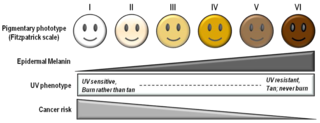
Dark matter is a form of matter thought to account for approximately 85% of the matter in the universe and about a quarter of its total mass–energy density or about 2.241×10−27 kg/m3. Its presence is implied in a variety of astrophysical observations, including gravitational effects that cannot be explained by accepted theories of gravity unless more matter is present than can be seen. For this reason, most experts think that dark matter is abundant in the universe and that it has had a strong influence on its structure and evolution. Dark matter is called dark because it does not appear to interact with the electromagnetic field, which means it does not absorb, reflect or emit electromagnetic radiation, and is therefore difficult to detect.

Pleochroism is an optical phenomenon in which a substance has different colors when observed at different angles, especially with polarized light.
A massive astrophysical compact halo object (MACHO) is any kind of astronomical body that might explain the apparent presence of dark matter in galaxy halos. A MACHO is a body that emits little or no radiation and drifts through interstellar space unassociated with any planetary system. Since MACHOs are not luminous, they are hard to detect. MACHO candidates include black holes or neutron stars as well as brown dwarfs and unassociated planets. White dwarfs and very faint red dwarfs have also been proposed as candidate MACHOs. The term was coined by astrophysicist Kim Griest.

Darkness, the polar opposite of brightness, is understood as a lack of illumination or an absence of visible light.

Hair color is the pigmentation of hair follicles due to two types of melanin: eumelanin and pheomelanin. Generally, if more eumelanin is present, the color of the hair is darker; if less eumelanin is present, the hair is lighter. Levels of melanin can vary over time causing a person's hair color to change, and it is possible to have hair follicles of more than one color on the same person. Particular hair colors are often associated with ethnic groups, while gray or white hair is associated with age.

Brown hair is the second most common human hair color, after black hair. It varies from light brown to almost black hair. It is characterized by higher levels of the dark pigment eumelanin and lower levels of the pale pigment pheomelanin. People with brown hair are often referred to as brunette, which in French is the feminine form of brunet, the diminutive of brun.

Eye color is a polygenic phenotypic character determined by two distinct factors: the pigmentation of the eye's iris and the frequency-dependence of the scattering of light by the turbid medium in the stroma of the iris.

A chemically pure and structurally perfect diamond is perfectly transparent with no hue, or color. However, in reality almost no gem-sized natural diamonds are absolutely perfect. The color of a diamond may be affected by chemical impurities and/or structural defects in the crystal lattice. Depending on the hue and intensity of a diamond's coloration, a diamond's color can either detract from or enhance its value. For example, most white diamonds are discounted in price when more yellow hue is detectable, while intense pink diamonds or blue diamonds can be dramatically more valuable. Of all colored diamonds, red diamonds are the rarest. The Aurora Pyramid of Hope displays a spectacular array of naturally colored diamonds, including red diamonds.
Dark Ages or Dark Age may refer to:

Apamea crenata, known as the clouded-bordered brindle, is a moth in the Noctuidae family. It is distributed throughout the Palearctic realm.
The Bortle scale is a nine-level numeric scale that measures the night sky's brightness of a particular location. It quantifies the astronomical observability of celestial objects and the interference caused by light pollution. John E. Bortle created the scale and published it in the February 2001 edition of Sky & Telescope magazine to help amateur astronomers evaluate the darkness of an observing site, and secondarily, to compare the darkness of observing sites. The scale ranges from Class 1, the darkest skies available on Earth, through Class 9, inner-city skies. It gives several criteria for each level beyond naked-eye limiting magnitude (NELM). The accuracy and utility of the scale have been questioned in recent research. The table below summarizes Bortle's descriptions of the classes. Some classes can have very drastic differences from the one next to it, e.g, Bortle 4 to 5.

The Fitzpatrick scale is a numerical classification schema for human skin color. It was developed in 1975 by Thomas B. Fitzpatrick as a way to estimate the response of different types of skin to ultraviolet (UV) light. It was initially developed on the basis of skin color to measure the correct dose of UVA for PUVA therapy, and when the initial testing based only on hair and eye colour resulted in too high UVA doses for some, it was altered to be based on the patient's reports of how their skin responds to the sun; it was also extended to a wider range of skin types. The Fitzpatrick scale remains a recognized tool for dermatological research into human skin pigmentation.

Olive skin is a human skin colour spectrum. It is often associated with pigmentation in the Type III to Type IV and Type V ranges of the Fitzpatrick scale. It generally refers to light or moderate brown, brownish, or tan skin, and it is often described as having yellow, green, or golden undertones.

Apamea lateritia, the scarce brindle, is a moth of the family Noctuidae. It is found in much of the Palearctic. It is a sporadic migrant in Great Britain, where it is recorded from the east and south-east coasts.

Euphyia biangulata, the cloaked carpet, is a moth of the family Geometridae. It is found in most of Europe and the Middle East.
The Martin–Schultz scale is a standard color scale commonly used in physical anthropology to establish more or less precisely the eye color of an individual; it was created by the anthropologists Rudolf Martin and Bruno K Schultz in the first half of the 20th century. The scale consists of 20 colors that correspond to the different eye colors observed in nature due to the amount of melanin in the iris :
Ypsolopha schwarziella is a moth of the family Ypsolophidae. It is known from the United States, including Arizona, Utah and California.
The Senegalese cobra is a species of cobra in the genus Naja that is found in West Africa. This species was long thought to be identical to the Egyptian cobra, but morphological and genetic differences have led to its recognition as a separate species. It differs from Naja haje in normally having more than 23 dorsal scale rows around the neck and a uniformly dark head without any obvious pattern on the supralabial scales.

The Martin scale is an older version of color scale commonly used in physical anthropology to establish more or less precisely the eye color of an individual; it was created by the anthropologist Martin in the first half of the 20th century. Later he improved this scale with cooperation of Dr. Schulz – the Martin-Schultz scale.












